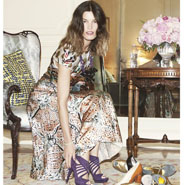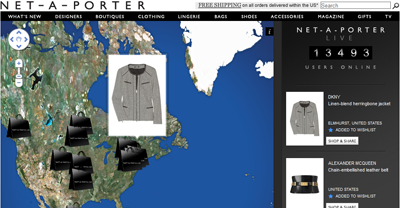
Luxury labels need to use digital media to target affluent consumers as they move through the purchase funnel, according to findings from a study by Boston Consulting Group.
The five components of the purchase funnel are awareness, customer engagement, customer acquisition and referral, usage and share of wallet and customer loyalty and retention. Using the purchasing funnel and being experimental and innovative in digital efforts is one of the only ways brands can be successful in that medium.
“Brands are struggling with metrics and one of the reasons for this was that companies are not always explicit about what they are trying to achieve with social media,” said Kate Sayre, New York-based managing director and partner at BCG and co-author of the study.
“From an innovation standpoint, companies are becoming much more open and moving beyond the experimentation phase and becoming more innovative with their approaches,” she said.
“The challenge that people are finding with things like social media and mobile unlike other digital advertising is that others can be more measured.”
Reaching too far
Luxury brands that use social media to their full advantage to hook customers via innovative and experimental means have the best chance of success, according to the Oscar de la Renta CEO (see story).
 Oscar de la Renta uses Facebook commerce
Companies at the experimental stage only use approximately 10 percent of their allocated budget for digital media, according to the study. This makes it hard for them to use the medium to their full advantage.
When brands get to the digitally-evolved stage, which is more than 20 percent or in some cases more than 50 percent, they are actively launching advocacy programs for brand influencers, refining their use of multiple online channels and tools, empowering employees to respond to customers and using specialty agencies to strengthen their digital campaigns, per the study .
At this point, brands are building an infrastructure to deliver data from social media to relevant internal business groups such as sales, product development and customer service.
However, one of the main challenges cited by 77 percent of respondents is that they do not know where to reach customers, according to the study.
Within those numbers, brands also have trouble distributing talent throughout capabilities, organization design and culture.
This is especially relevant in the luxury industry, since there seems to be a war between those who believe digital is crucial to building relationships with potential consumers and those who think the hub makes an elite brand too accessible by consumers who cannot afford products.
Therefore, brands must address four critical areas: aligning the digital marketing strategy with business objectives, building internal capabilities, tailoring organization design to operations and creating a culture that embraces digital marketing and encourages experimentation.
It is only then that luxury brands can provide a luxury experience that does not dilute the brand while still being accessible.
Social butterfly
Even though luxury brands are typically the slowest to get out of the gate when it comes to innovation, some brands have been doing a good job.
One example is when Burberry engaged with consumers when it came out with its new Burberry Body scent.
Oscar de la Renta uses Facebook commerce
Companies at the experimental stage only use approximately 10 percent of their allocated budget for digital media, according to the study. This makes it hard for them to use the medium to their full advantage.
When brands get to the digitally-evolved stage, which is more than 20 percent or in some cases more than 50 percent, they are actively launching advocacy programs for brand influencers, refining their use of multiple online channels and tools, empowering employees to respond to customers and using specialty agencies to strengthen their digital campaigns, per the study .
At this point, brands are building an infrastructure to deliver data from social media to relevant internal business groups such as sales, product development and customer service.
However, one of the main challenges cited by 77 percent of respondents is that they do not know where to reach customers, according to the study.
Within those numbers, brands also have trouble distributing talent throughout capabilities, organization design and culture.
This is especially relevant in the luxury industry, since there seems to be a war between those who believe digital is crucial to building relationships with potential consumers and those who think the hub makes an elite brand too accessible by consumers who cannot afford products.
Therefore, brands must address four critical areas: aligning the digital marketing strategy with business objectives, building internal capabilities, tailoring organization design to operations and creating a culture that embraces digital marketing and encourages experimentation.
It is only then that luxury brands can provide a luxury experience that does not dilute the brand while still being accessible.
Social butterfly
Even though luxury brands are typically the slowest to get out of the gate when it comes to innovation, some brands have been doing a good job.
One example is when Burberry engaged with consumers when it came out with its new Burberry Body scent.
 Burberry Body
“Burberry experimented using social media to distribute samples of its new fragrance,” Ms. Sayre said. “Instead of the scattershot scent strip that you would get in a print magazine, they gave them the product in a more actual form.”
Another key factor for luxury brands is making sure that the experience across all channels is seamless.
One example is Tiffany & Co.’s Wall Street store in Manhattan. The brand enables customers to order something online and then pick up in the store.
“This is a good idea, but it’s a rare example of brands that have this kind of seamless interaction,” Ms. Sayer said.
Brands can also retain customers by improving customer satisfaction online.
For example, Net-A-Porter bolstered its digital presence with the addition of an interactive global map that highlights consumer purchases in real-time.
Burberry Body
“Burberry experimented using social media to distribute samples of its new fragrance,” Ms. Sayre said. “Instead of the scattershot scent strip that you would get in a print magazine, they gave them the product in a more actual form.”
Another key factor for luxury brands is making sure that the experience across all channels is seamless.
One example is Tiffany & Co.’s Wall Street store in Manhattan. The brand enables customers to order something online and then pick up in the store.
“This is a good idea, but it’s a rare example of brands that have this kind of seamless interaction,” Ms. Sayer said.
Brands can also retain customers by improving customer satisfaction online.
For example, Net-A-Porter bolstered its digital presence with the addition of an interactive global map that highlights consumer purchases in real-time.
 The live, interactive Net-A-Porter globe
The microsite is a large globe on which shopping bags pop up where a customer is purchasing a product or adding an item to her shopping bag.
“The biggest challenge with luxury [on social media] is, how do you create a community that is meaningful?” Ms. Sayre said.
“Typically, for many brands you can have very large social media communities and oftentimes they can be significantly larger than one that is on an individual Web site," she said.
“Therefore, the engagement of the community is driven by intimacy of that community or how likeminded it is, especially in the luxury space."
Final Take
Rachel Lamb, associate reporter on Luxury Daily, New York
The live, interactive Net-A-Porter globe
The microsite is a large globe on which shopping bags pop up where a customer is purchasing a product or adding an item to her shopping bag.
“The biggest challenge with luxury [on social media] is, how do you create a community that is meaningful?” Ms. Sayre said.
“Typically, for many brands you can have very large social media communities and oftentimes they can be significantly larger than one that is on an individual Web site," she said.
“Therefore, the engagement of the community is driven by intimacy of that community or how likeminded it is, especially in the luxury space."
Final Take
Rachel Lamb, associate reporter on Luxury Daily, New York
